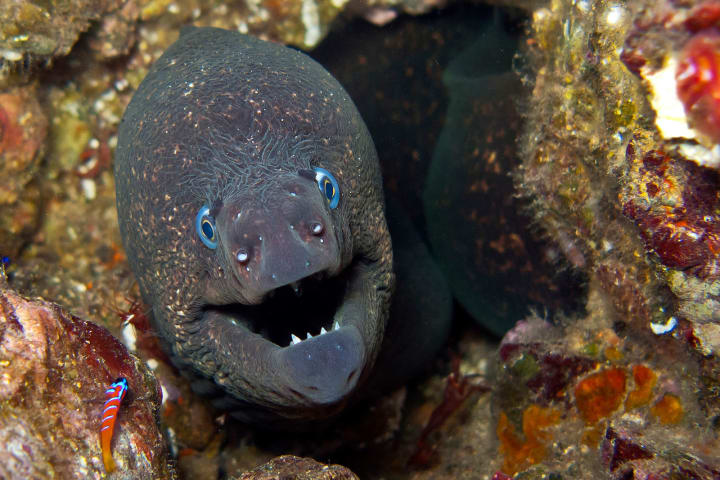Hydrus of Medieval Bestiaries
A cryptid referenced as far back as Ancient Rome.

The term "cryptid" may sound like a relatively new concept, and the word itself might make you think of something like the Loch Ness monster or Bigfoot. Modernly, the concept is essentially a creature undocumented by science, perhaps from folklore, that may or may not even exist.
Often, "science" (which is to say the larger scientific community) discards the notion of certain cryptids, even though new species are discovered all the time. I've written about this before, and even about a specific case of a creature from Sri Lankan folklore that turned out to be very real.
The question of "cryptids" isn't really answerable categorically, and each claim can and should be investigated on its own merits. Some claims, though, are so old that it's not exactly easy to explore. Like in the case of a creature known as the "Hydrus."
Not To Be Confused With Hydra
I'm sure you've heard of a hydra, but I just wanted to clarify immediately that "Hydrus" and "Hydra" are actually two distinct creatures. A hydra (aka, Lernaean Hydra or Hydra of Lerna) is a creature from Greek and Roman mythology. The name itself can be traced back to Ancient Greek (ὕδρα: húdra) and possibly even farther back to the Latin word "lutra," meaning "water snake, "otter," or "water wolves." We'll revisit that in a minute. For now, let's just all agree to call otters "water wolves."

The Lernaean Hydra is commonly portrayed as a many-headed snake; if you cut one head off, then two grow in its place. I've always wondered about the legend of the Hydra and what would happen if you just kept cutting off heads. Eventually, there would be no room left in the main body to accommodate more heads. You'd end up with a big tangle of them like an overstuffed Koosh ball that's so dense the heads would end up strangling themselves.
Obviously, today's water wolves don't exhibit this type of immortal behavior, so I think it's safe to say that the root words might be a bit of a misnomer.
What Is a Hydrus?
Most of what we know of the creature called a "Hydrus" comes to us from Medieval Bestiaries—books describing the world's...well, beasts. Some of the animals described and sketched within these bestiaries seemed far-fetched at the time, like hippos. This particular creature, a type of water snake, didn't originate in the bestiaries, though. Tales of it seem to go much farther back than the Middle Ages (500 to 1400–1500 CE). All the way back to Ancient Egypt (3100 B.C.E. to 332 B.C.E.).
The Hydrus was supposedly the mortal enemy of crocodiles in the Nile River.

Described as "snakelike," the Hydrus didn't have commonly agreed upon physical characteristics, and Ancient authors compared it to birds, others, and even dragons—which makes tracking what the creature might have been even more difficult.
The stories say that when the Hydrus and crocodile met, they fought, and the fight would always have the same outcome. The crocodile would overpower the smaller Hydrus and swallow it whole. Then, the Hydrus would burrow through the crocodile's stomach and eat its way out, killing the crocodile in the process. A pretty gruesome way to die.
As much as I'd like to think of otters—I mean water wolves—as vicious killing machines, I can't imagine an otter eating its way out of a stomach. Though interestingly, otters can be found in the Nile River.
Thinking back to what it must have been like before the days of Google, Wikipedia, Encyclopedia Britannica, nature documentaries, the Internet, and this newfangled invention called electricity—it must have been easy to believe that any creature could have existed, even water snakes that could burrow their way out of stomachs after being eaten, no matter how ridiculous it sounded.
Oh, wait.
That's a thing.
Check out this video about an eel that burrowed its way out of the stomach of a heron after being swallowed whole.
The average crocodile in the Nile River is between 4 meters (13.1 feet) to 4.5 meters (14.7 feet), weighing around 410 kg (900 lb). And, as it turns out, a species of eel called "Anguilla vulgaris" happens to live in the Nile River. The Anguilla vulgaris species of eel usually are around 60–80 cm (2.0–2.6 ft)—which just so happens to be around the same length as a small river otter.
Now, I'm not saying the Hydrus is an eel because there's really no way to know. But I will say that, after years of studying folklore and how stories originate and evolve over time, all it would have taken for a "mortal enemy of crocodiles" story to take shape is a single sighting of one eel very determined to stay alive.

Relevant & Related
- Hydrus appeared as a boss fight in Shadow of the Colossus. It's a good depiction, even though it's a bit bigger than a water wolf, though.
- Learn about Pliny the Elder, who wrote about the Hydrus.
- There's an ongoing effort underway to put Medieval Bestiaries online. Check out the entry for the Hydrus.
- To find out more about Medieval Bestiaries, start here with this short documentary.
- And pulling from medieval stories, here are 10 of the strangest medieval monsters.
- If that wasn't scary enough, here are 25 documented terrifying sea creatures to keep you up at night.
- Want to read more about cryptids and sea monsters? Check out some other articles I've written: Hodag of American Folklore | El Peuchen of Mapuche Mythology | The Qalupalik of Inuit Folklore | The Oklahoma Octopus | Tracking Tahoe Tessie Down | Owlman of Mawnan, Cornwall | Morgawr of Cornwall, England
~
Originally published in my weekly newsletter Into Horror History - every week, I explore the history and lore of horror, from influential creators to obscure events. Cryptids, ghosts, folklore, books, music, movies, strange phenomena, urban legends, psychology, and creepy mysteries.
About the Creator
J.A. Hernandez
J.A. Hernandez enjoys horror, playing with cats, and hiding indoors away from the sun. Also, books. So many books—you wouldn't believe.
He runs a weekly newsletter called Into Horror History and writes fiction.
https://www.jahernandez.com






Comments
There are no comments for this story
Be the first to respond and start the conversation.